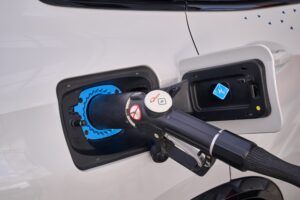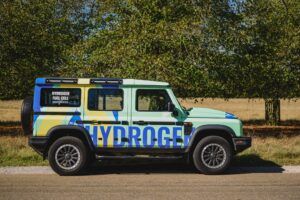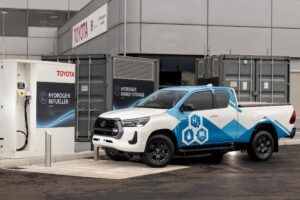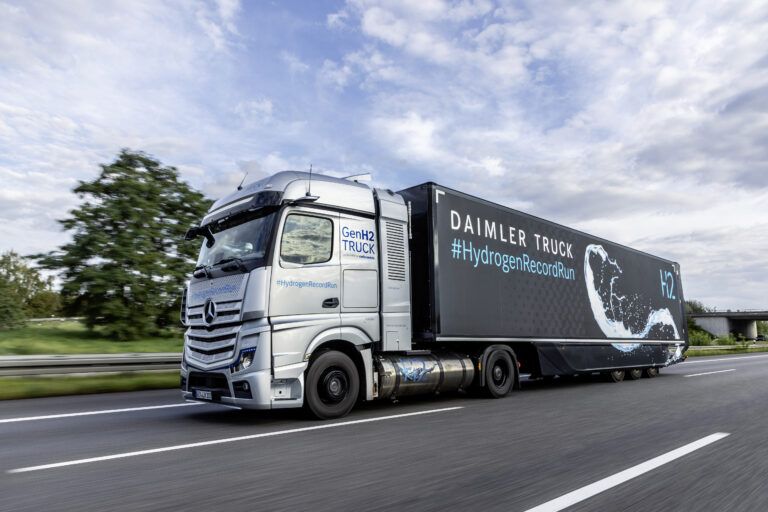The challenge of rolling out hydrogen vehicles at scale lies not only in perfecting the automotive technology, but also in ensuring the deployment of an adequate fueling network. We take a look at the international picture and discover plans being made and deals being done to enable a viable zero-emissions alternative to battery electrification
On the path to zero emissions solutions, a large majority of vehicles are expected to be electrified but there’s a significant requirement for an alternative fuel to service heavier vehicles including HGVs (heavy goods vehicles) and plant equipment.
Road freight emits a disproportionate amount of emissions compared to the number of HGVs on the road. Despite only accounting for 6% of vehicle miles in 2020, HGVs emitted 19% of transport emissions in the UK. The proposed way to clean up the heavier end of road transport is hydrogen.
Whilst battery electric trucks are currently available to purchase, these are anywhere from two to four times more expensive than an equivalent diesel truck and hydrogen HGVs are not yet on the market. However, manufacturers like Daimler Truck, Iveco and the Volvo Group are developing hydrogen fuel cell electric vehicles (FCEVs) to bring to market at the end of this decade. But countries need to have reliable hydrogen infrastructure to support the roll out of these vehicles.
Some regions are ahead of others in hydrogen infrastructure deployment. The US currently has 59 hydrogen refueling stations, but they are all concentrated in California where customers have the choice of three hydrogen car models.
In California the Toyota Mirai is the most popular new hydrogen car in the state. Honda has discontinued its Clarity Fuel Cell model since it wasn’t selling in strong numbers but there will still be used examples on the road.
Hyundai’s Nexo SUV is available to purchase new in the US, but sales sit far behind Toyota’s Mirai. It’s estimated around 15,000 hydrogen fuel cell vehicles are on the road in California. Just under 11,000 of these are Mirai passenger cars and around 200 of the total are fuel-cell buses.
Elsewhere in the world, South Korea is a leader in FCEV adoption with two thirds of the 15,000 fuel cell cars sold in 2022 going to customers in Korea. According to the IEA Global Hydrogen Review 2022, the country has favorable policies to support the production and sale of FCEVs.
China is not only dominating the passenger car EV market, it’s also deploying more fuel-cell trucks more than any other country. Over 95% of the world’s fuel cell-trucks are in China along with 85% of all fuel-cell buses which amounts to just over 5,000 trucks and around 4,000 buses. FCEV cars made up a very small portion of hydrogen vehicles in China in 2022.
Japan is also a world leader in hydrogen with more than 6,500 FCEV cars on the road. In Europe, Germany, the Netherlands and Norway are the countries with the most hydrogen cars, collectively accounting for more than 1,500 vehicles. According to Hydrogen UK, as of 2023, Germany has 91 hydrogen stations, France has 51, the UK has 11 and Switzerland has 10.
But pressure is building in the UK for more to be done to support hydrogen vehicles with Hydrogen UK and the Energies Network Association is calling on the UK Government to provide regulatory certainty around the future of hydrogen and net zero targets to encourage private companies to invest in infrastructure and technology development.
 The hydrogen plan in the UK
The hydrogen plan in the UK
Given the specific use case of hydrogen predominately for HGVs, initial infrastructure in the UK will be built to support the two main trunk routes on either side of the country. These fueling stations will be similar to traditional forecourts and deliver pressurized hydrogen gas in roughly the same amount of time it takes to fill up with diesel. Hydrogen infrastructure provider Element 2 estimates just seven fueling stations would be required to support the implementation of hydrogen trucks. But the company has greater ambitions to build a UK wide hydrogen network by 2027.
Senior business manager at Element 2, Nick Shelley, says: “We have an ambition as Element 2 to build a UK-wide network of safe high quality hydrogen refueling stations by 2027. What that means is, in reality, this will be commercial transport focused, there will be pockets of hydrogen out there, but it will be where the trucks and the commercial vehicles are going.”
It’s important to note, the UK has two hydrogen car models available to purchase. But refueling stations peaked at 15 sites before little to no demand meant some sites closed down. After becoming the first company to open a hydrogen refueling station in the UK in 2017, Shell shut its sites at Gatwick airport, Cobham and Beaconsfield motorway services. There are now around 11 operational hydrogen stations in the UK.
Until such time as hydrogen is easily accessible, companies like Element 2 are supporting initial hydrogen vehicle trials with mobile refueling facilities. Despite some hydrogen station closures Jon Regnart-Russell, senior policy advisor at Hydrogen UK says: “While numbers [of hydrogen refueling stations] have remained consistent, and some have closed, the actual dispensing capacity has actually gone up in the industry. The hydrogen refueling infrastructure is gearing itself up for higher dispensing capacities for the commercial vehicle sector.”
Who’s investing?
Vehicle OEMs themselves want reassurance from industry that hydrogen refueling stations will continue to be built, this means deals are being done directly with energy companies. “We’ve signed a memorandum of understanding with Daimler with a commitment to build 25 hydrogen refueling stations by the end of 2030,” says Adrian Brabazon, head of UK fleet solutions at BP.
But that doesn’t mean government intervention is not still important, Brabazon also explains that progress on the continent is better thanks to clear policies and subsidies for HGV fleet operators and infrastructure providers.
The carbon footprint for new vehicles is generally calculated based on the fuel it will use over its life rather than the energy used to make the vehicles before it leaves the factory. CEO at Progressive Energy, Chris Manson-Whitton, provides a different insight in the race to reach net zero: “All the car manufacturers are obviously building zero-emission vehicles but they all have a real appetite to make sure that the embodied carbon in the vehicles they are producing is as low as possible.”
As a result, Progressive Energy is working with its partners to decarbonize JLR’s manufacturing facilities in Halewood, Liverpool, UK, using hydrogen. This includes decarbonizing other businesses in JLR’s supply chain to reduce the footprint of materials entering the manufacturing facility. These changes mean before hydrogen cars ever roll off the production line hydrogen will be used to reduce the emissions created during manufacturing regardless of what fuel type a car will use.
 What must governments do?
What must governments do?
From Hydrogen UK’s point of view, Regnart-Russell says: “We’d like the UK Government to be a bit more ambitious in its hydrogen refueling solutions (HRS) rollout. In Europe there’s the alternative fuel infrastructure regulation that mandates a minimum amount of hydrogen refueling stations every 200km and sets the dispensing rate and regulation around pressure. We’d very much like to mirror that EU approach of having some sort of regulatory certainty around HRS.”
Regnart-Russell notes this confidence in the future of hydrogen in Europe has allowed joint ventures and consortiums to form such as H2 Accelerate which is jointly producing technology and infrastructure for hydrogen HGVs. H2 Accelerate members include Daimler Truck, Iveco Group, Volvo Group, Shell, TotalEnergies and Linde.
Manson-Whitton explains that government support to decarbonize industry operations will set the infrastructure in place for refueling providers to draw from. Building a nationwide hydrogen pipe network will take time but using existing gas lines and starting as soon as possible will ensure the UK can support industries and vehicles with hydrogen.
Although hydrogen vehicles might seem like a distant vision, hydrogen trucks and cars are already on the road being trialed across the UK and Europe. As with any new technology, the vehicles and fuel will be more expensive until production, demand and uptake drive costs down.
The 1,000km truck
The vast majority of hydrogen infrastructure focuses on gaseous hydrogen however, manufacturers such as Daimler are also developing trucks to run on liquid hydrogen. In its liquid form hydrogen has a significantly higher energy density in relation to volume but it takes a lot of energy to cool and keep hydrogen at -253°C.
At the end of September 2023 Daimler set a new record and hit a development milestone when its prototype FCEV covered over 1,000km on a single fill of liquid hydrogen.
“To decarbonize transport, we need both battery-electric and hydrogen-powered drive technologies,” says Andreas Gorbach, head of truck technology at Daimler Truck. “The sweet spot for fuel cell trucks lies in flexible and demanding long-haul transportation tasks. By cracking the 1,000km mark with one fill we are making very good progress on the road to series production. At the same time, our record run is a reminder that decarbonizing transportation requires two other factors in addition to the right drive technologies: a green energy infrastructure and competitive costs compared to conventional vehicles.”
 Hydrogen cars in the UK
Hydrogen cars in the UK
Currently there’s just two hydrogen cars available to purchase in the UK, the Toyota Mirai and the Hyundai Nexo. As these vehicles are sold in other markets, it’s unlikely they will disappear from sale unless global demand for hydrogen cars declines. However, until there’s a larger and more reliable hydrogen refueling network in the UK there’s very little incentive for customers to consider hydrogen vehicles unless they live close to a refueling station.
BMW is trialing 100 hydrogen iX5 models across Europe but speaking to <The Times> earlier this year, Juergen Guldner, general programme manager for hydrogen at BMW said, “if there is infrastructure being built out in the UK, we will be ready to bring a car to the market in the UK. [Failing that] we will bring the cars to Japan and Korea and the rest of Europe, where there is a refueling station network being built.”
It’s unlikely manufacturers will launch new hydrogen cars here until the UK has adequate infrastructure to support mass adoption. Based on the trajectory of hydrogen infrastructure development, Asia and Europe will see hydrogen passenger cars long before the UK.
Guldner believes adoption of hydrogen in the commercial transport sector could unlock access to hydrogen refueling for passenger cars but until that point, support for passenger cars will be minimal. Given EV infrastructure has rapidly expanded and there’s far more EVs on the road than hydrogen cars, electric will likely take over as the preferred low carbon fuel for passenger cars.
That doesn’t mean manufacturers are abandoning the idea of hydrogen for cars. Companies such as INEOS and Toyota are developing hydrogen models for off-road vehicles and pickup trucks which would benefit from the range capabilities and short refuelling times afforded by hydrogen.





